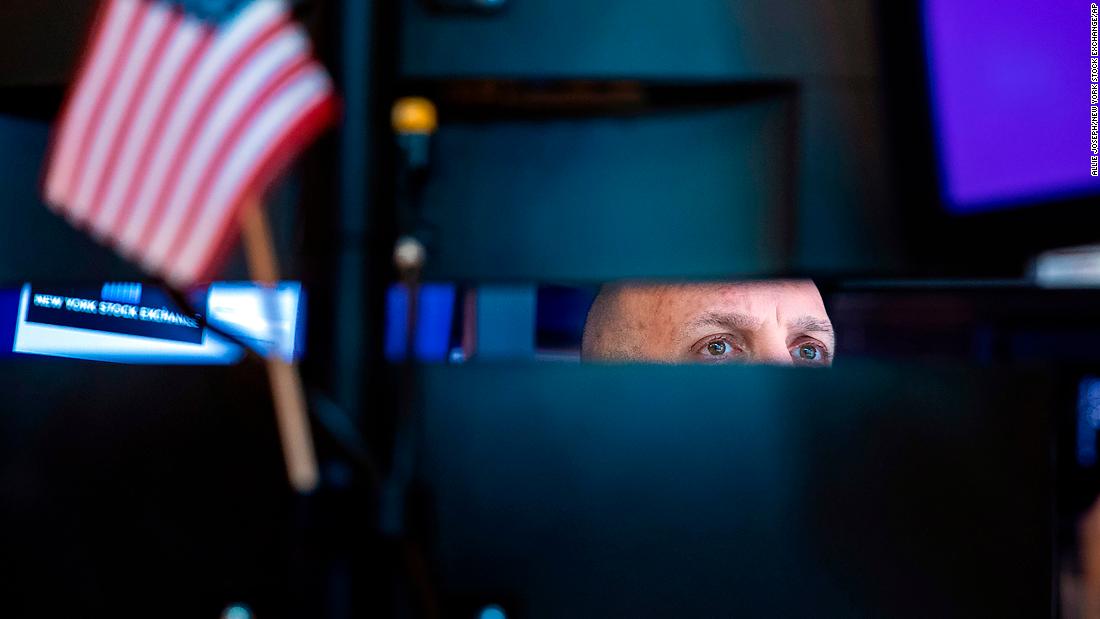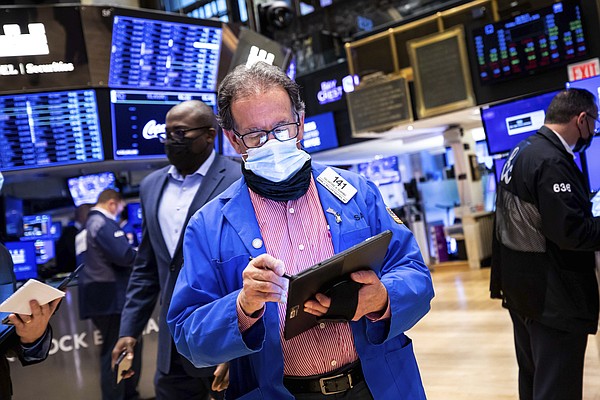BEIJING (AP) — Asian stock markets rebounded on Thursday and oil prices rose after the head of the Federal Reserve said he supported a lower interest rate hike than some had expected.
Shanghai, Tokyo, Hong Kong and Sydney advanced even as Russian forces whose attack on Ukraine rocked financial markets bombarded the country’s second-largest city and besieged two ports.
Wall Street’s benchmark S&P 500 rose 1.9% on Wednesday, recouping this week’s losses after Fed Chairman Jerome Powell said the US central bank was poised to hike its rate director for the first time since 2018. He said he supported a traditional rate hike of 0.25 percentage points instead of the larger hike recommended by some policymakers.
Powell said the impact on the US economy of Russia’s attack is “highly uncertain.”
“Markets reacted positively to the remarks, which is a questionable interpretation of Powell’s nuanced comments,” ING economists said in a report. “Volatility is key here, and uncertainty. That’s not going away anytime soon.”
The Nikkei 225 in Tokyo rose 0.8% to 26,608.21 and the Hang Seng in Hong Kong gained 0.6% to 22,469.66. The Shanghai Composite Index rose 0.1% to 3,487.78.
Seoul’s Kospi gained 1.6% to 2,745.45 and Sydney’s S&P-ASX 200 rose 0.8% to 7,171.10. New Zealand and Southeast Asian markets also grew.
Stock prices have fluctuated wildly as investors try to figure out how the Russian attack will affect supplies of oil, wheat and other raw materials and the global recovery from the coronavirus pandemic.
Traders were already worried about plans by the Fed and other central banks to fight inflation by withdrawing ultra-low interest rates that have boosted stock markets.
The S&P 500 rose to 4,386.54. The Dow Jones Industrial Average gained 1.8% to 33,891.35. The Nasdaq composite advanced 1.6% to 13,752.02.
Over 90% of S&P 500 stocks rose. Technology, finance and healthcare companies accounted for a large share of the rally. Energy stocks also helped push the index higher due to higher oil prices.
Ford Motor Co. jumped 8.4% after announcing it was accelerating its transformation into an electric vehicle company and separating its electric vehicle and internal combustion businesses.
The yield on the 10-year Treasury bond, or the difference between its market price and the payment at maturity, rose to 1.89% from 1.72% on Tuesday. However, yields were still lower than they were before the Russian invasion.
In energy markets, benchmark U.S. crude rose another $2.68 to $113.28 a barrel in electronic trading on the New York Mercantile Exchange. Brent crude, the price base for international oils, added $3.61 to $116.54 a barrel in London.
Both gains were lower than Wednesday’s surge of over $7 a barrel, but still unusually wide margins for a daily change.
Leaders of OPEC and other major oil exporters decided on Wednesday to stick to plans for a gradual increase in production. The coalition, made up of OPEC members led by Saudi Arabia and non-cartel members led by Russia, opted to increase production by 400,000 barrels per day in April.
Also this week, the United States and other major oil consumers at the International Energy Agency agreed to release 60 million barrels of strategic reserves to boost supply. But this had little impact on market prices.
In currency markets, the Russian ruble gained 3.4% against the US dollar, but was still near a record low of less than 1 cent. It has fallen nearly 25% since the attack after Western governments imposed sanctions that cut off much of Russia’s access to the global financial system.
The dollar gained 115.63 yen from 115.58 yen on Wednesday. The euro fell to $1.1097 from $1.1126.
 Stocks shrugged off an afternoon slump and ended higher on Wall Street on Wednesday after the Federal Reserve announced its first interest rate hike since 2018. Bond yields also rose as the Fed began to shift its policy focus to fighting inflation. As markets had expected, the Fed raised its short-term rate by 0.25 percentage […]]]>
Stocks shrugged off an afternoon slump and ended higher on Wall Street on Wednesday after the Federal Reserve announced its first interest rate hike since 2018. Bond yields also rose as the Fed began to shift its policy focus to fighting inflation. As markets had expected, the Fed raised its short-term rate by 0.25 percentage […]]]> ]]>
]]> stock index in Hong Kong, Monday, March 14, 2022. Stocks were mixed in Asia and oil prices were flat on Monday as Uncertainty over the war in Ukraine and persistently high inflation left investors guessing what to expect. (AP Photo/Kin Cheung)” title=”A woman wearing a face mask walks past a bank’s electronic board showing the Hong Kong stock index in Hong Kong, Monday, March 14, 2022. Stocks were mixed in Asia and oil prices were flat on Monday as Uncertainty over the war in Ukraine and persistently high inflation left investors guessing what to expect. (AP Photo/Kin Cheung)” loading=”lazy”/>
stock index in Hong Kong, Monday, March 14, 2022. Stocks were mixed in Asia and oil prices were flat on Monday as Uncertainty over the war in Ukraine and persistently high inflation left investors guessing what to expect. (AP Photo/Kin Cheung)” title=”A woman wearing a face mask walks past a bank’s electronic board showing the Hong Kong stock index in Hong Kong, Monday, March 14, 2022. Stocks were mixed in Asia and oil prices were flat on Monday as Uncertainty over the war in Ukraine and persistently high inflation left investors guessing what to expect. (AP Photo/Kin Cheung)” loading=”lazy”/> BEIJING (AP) — Asian stock markets rebounded on Thursday and oil prices rose after the head of the Federal Reserve said he supported a lower interest rate hike than some had expected. Shanghai, Tokyo, Hong Kong and Sydney advanced even as Russian forces whose attack on Ukraine rocked financial markets bombarded the country’s second-largest city […]]]>
BEIJING (AP) — Asian stock markets rebounded on Thursday and oil prices rose after the head of the Federal Reserve said he supported a lower interest rate hike than some had expected. Shanghai, Tokyo, Hong Kong and Sydney advanced even as Russian forces whose attack on Ukraine rocked financial markets bombarded the country’s second-largest city […]]]> The Dow Jones fell nearly 600 points on Tuesday, or 1.8%, a day after stocks closed their second consecutive monthly decline to start the year. The Dow, however, managed to end its lows of the day. The Nasdaq and S&P 500 were also hit hard, with each index falling about 1.6%. Rising oil prices, which […]]]>
The Dow Jones fell nearly 600 points on Tuesday, or 1.8%, a day after stocks closed their second consecutive monthly decline to start the year. The Dow, however, managed to end its lows of the day. The Nasdaq and S&P 500 were also hit hard, with each index falling about 1.6%. Rising oil prices, which […]]]> By Bill SchmickChronicler of the iBerkshires4:23 p.m. / Friday, February 18, 2022 Over the next three weeks, stocks will likely trade in a wide range. The caveat to this forecast: if the Fed suddenly changes policy, or if a deadly war breaks out in Ukraine. Those are two big ifs. Unfortunately, I can’t predict when […]]]>
By Bill SchmickChronicler of the iBerkshires4:23 p.m. / Friday, February 18, 2022 Over the next three weeks, stocks will likely trade in a wide range. The caveat to this forecast: if the Fed suddenly changes policy, or if a deadly war breaks out in Ukraine. Those are two big ifs. Unfortunately, I can’t predict when […]]]>
/cloudfront-us-east-2.images.arcpublishing.com/reuters/TYYXITSMYNONJMLGTMJJFDVFTI.jpg) A ‘Wall St’ sign is seen above two ‘One Way’ signs in New York August 24, 2015. REUTERS/Lucas Jackson Join now for FREE unlimited access to Reuters.com Register NEW YORK, Feb 7 (Reuters) – Liquidity in U.S. stocks has fallen to levels not seen during the COVID-19 sell-off two years ago, adding volatility to an […]]]>
A ‘Wall St’ sign is seen above two ‘One Way’ signs in New York August 24, 2015. REUTERS/Lucas Jackson Join now for FREE unlimited access to Reuters.com Register NEW YORK, Feb 7 (Reuters) – Liquidity in U.S. stocks has fallen to levels not seen during the COVID-19 sell-off two years ago, adding volatility to an […]]]> NEW YORK – Wall Street ended a rather bullish week for stocks on Friday with a mixed end to major indexes and a surge in Treasury yields after a U.S. jobs report shattered investor expectations that the Federal Reserve may soon begin to raise interest rates sharply. The S&P 500 settled for a 0.5% gain […]]]>
NEW YORK – Wall Street ended a rather bullish week for stocks on Friday with a mixed end to major indexes and a surge in Treasury yields after a U.S. jobs report shattered investor expectations that the Federal Reserve may soon begin to raise interest rates sharply. The S&P 500 settled for a 0.5% gain […]]]>
 BEIJING (AP) — Wall Street pointed to a lower open on Monday on the heels of last week’s furious rally that gave major stock indexes their biggest gains of the year. On Wall Street, futures on the benchmark S&P 500 slid 0.5% while futures on the Dow Jones Industrial Average fell 0.7%. Global stocks rose […]]]>
BEIJING (AP) — Wall Street pointed to a lower open on Monday on the heels of last week’s furious rally that gave major stock indexes their biggest gains of the year. On Wall Street, futures on the benchmark S&P 500 slid 0.5% while futures on the Dow Jones Industrial Average fell 0.7%. Global stocks rose […]]]> Here are the most important news, trends and analysis that investors need to start their trading day: 1. Wall Street’s worst selloff since March 2020 continues Traders on the floor of the NYSE, January 27, 2022. Source: NYSE Volatility continued on Friday, with Dow futures swinging wildly. Dow Chevron stock fell more than 4% pre-market, […]]]>
Here are the most important news, trends and analysis that investors need to start their trading day: 1. Wall Street’s worst selloff since March 2020 continues Traders on the floor of the NYSE, January 27, 2022. Source: NYSE Volatility continued on Friday, with Dow futures swinging wildly. Dow Chevron stock fell more than 4% pre-market, […]]]>